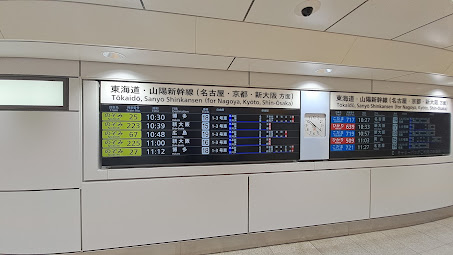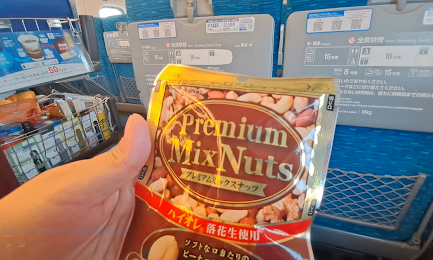When you hear about bullet trains, you think of Japan — with its famous attractions from Tokyo to Osaka as well as their extreme level of hospitality and good manners of its people. But did you know that their Shinkansen is also one of Japan's famous "attractions" and landmarks?
 |
| Shinkansen trains at Tokyo Station. |
In operation since 1964, the Shinkansen has transformed the lives of the Japanese, as it pulled cities closer than ever before. It shortened travel times between Tokyo and Osaka — two of Japan's largest cities and famous tourist hotspots — from almost seven hours on a conventional limited express train to only 2.5 hours today!
This blog covers my experience on the 515-kilometer Tokaido Shinkansen — the original line opened — as part of my first-ever trip to Japan in July 2023.
How we bought our tickets?
For first-time travelers, I highly recommend buying your tickets on online platforms like Klook — which has a more comprehensive guide by clicking/tapping here to see it. In our case, however, we ditched this option and only used Klook in buying tickets for various attractions, like Tokyo Disneyland and Universal Studios Japan in Osaka.
 |
| That's me at the JR East Travel Center at Shinjuku Station! Unfortunately, I was not able to picture the interior of it. |
We instead bought our tickets at Shinjuku Station in Tokyo. We bought it from an agent at a JR East Travel Center. Although I saw several machines around several subway stations in Tokyo, we bought it from a human agent so that I could familiarize myself with buying express train tickets in Japan.
I highly recommend buying IN ADVANCE to get the best reservations! We bought this two days before our trip. Each standard ticket from Tokyo to Osaka costs 14,520 yen ($96, or around 5,600 Philippine pesos). Worth noting that we traveled as a group of three: myself, my mother, and my father, thus, tripling the purchase price.
Main review
It was a clear, Tuesday morning, July 4, 2023. Waking up at past 7:00 for my breakfast, we rode a taxi from our guest house in Asakusabashi to central Tokyo Station — a major railway hub for Shinkansen services, JR lines, and the Tokyo subway network.
 |
| This is the entrance for Shinkansen services at Tokyo Station. |
There are three services on the Tokaido Shinkansen:
- Nozomi - the fastest Shinkansen service. Japan Rail Pass holders are ineligible to travel with this service except when you buy a supplementary ticket to get on this train.
- Hikari - although stopping at more stations than Nozomi, it is the fastest service eligible for Japan Rail Pass holders. With the pass, you can ride this free of charge.
- Kodama - stops at all stations, making it the slowest. Applicable only for travel to secondary or tertiary stations or cities.
Although the Tokaido Shinkansen ends at Shin-Ōsaka, it continues for 553.7 kilometers more as the San'yō Shinkansen, ending at Hakata Station in Fukuoka. It is worth noting that some services continue to Hakata.
 |
| An information screen showing the train designation, number, departure time, destination, and the stops it would make along the way. |
With our pre-purchased tickets handy with us from two days ago, we inserted our tickets to the fare gates. It marked the start of a dream come true: to ride the most popular trains in Japan! We then went up to the platforms.
 |
| Shinkansen platforms of Tokyo Station. |
At 10:45, our train arrived. Passengers from the previous trip first alight, with the cleaning crew (locally tessei) already prepared to clean the train. Soon after, they would clean the train for roughly 7 MINUTES, making this known as the "7-minute miracle". The seats are also rotated to the other direction as well. I loved that despite that quick timeframe, they were able to make our train free of any litter and dirt that would otherwise make our trip awful. A huge arigato to the cleaning crew!
We took the Nozomi service. Our train was scheduled to leave at 11:00. The Japanese are known to be punctual (almost all the time!), and our train departed right ON TIME! The Shinkansen is also known as the world's most punctual train. A bullet train rides from Tokyo to Shin-Ōsaka takes exactly 2.5 hours with a maximum operating speed of 285 km/h, meaning that we would arrive at 13:30.
 |
| Interior of our standard car Shinkansen train. |
The Shinkansen has two types of classes: standard and green. Standard seats are configured 2-3, depending on the direction, while green class seats are more spacious and is configured in 2-2. We opted for the standard class for this trip. The trains are 16 cars long (roughly 404.7 meters); each car is 25 meters long while the end cars are 27.35 meters long.
 |
| My seat of the Shinkansen train. |
From Tokyo to Shin-Ōsaka, Nozomi trains stop at Shinagawa, Shin-Yokohama, Nagoya, and Kyoto. The trip was relatively uneventful, but I enjoyed it so much because this was my dream train.
The seat was relatively comfortable. It comes with a working tray table, a clean seat pocket, and, interestingly, a charging port! The problem for chargers, is that voltage supply may fluctuate, at least according to the signs. The windows are equipped with shades as well.
 |
| My light peanuts snack I ordered for just $1.3! |
Past an hour into the trip, the trolley service began. I chose to order a light snack for only 200 Japanese yen. Trolley services were once the practice until October 2023, when those were phased out. Since then, bringing your own snacks or meals that you can buy at convenience stores or vending machines is recommended.
Just past one, I realized that my fun is soon ending. We were soon arriving Shin-Ōsaka Station. At 13:30, we arrived. I was shocked that the 2.5 hours travel time that the station agent told us two days ago was correct. We then ate lunch at a restaurant within the paid area of Shin-Ōsaka after doing a little bit of trainspotting at the platforms. We then left for our hotel. We stayed in Osaka for the next four days until our return flight home.
Watch my video of this trip report here:
See also my other Japan blogs:
For more updates, visit my blog site and subscribe to my YouTube channel, Enzo's Travel Journals!

Comments
Post a Comment